Fly fishers compare every activity to fly fishing, though in this case, it's possible outdoor photography actually
is a lot like fly fishing.
Both thrive in the presence of a zen perspective; either can place you amidst stunning beauty; and neither reacts well to the application of brute force.
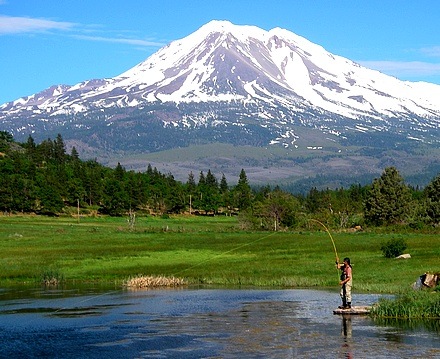
A closeup would have been nice, but the Zen storyteller takes a second to look.Complicating the process is humankind's desire to reduce art to science, and the scads of "Top 10 Technical Tips for Better Pictures" articles reflect that need.
Reading them actually does improve your photography, but they often don't frame the act with the proper Zen attitude -- a focused, high-altitude perspective that transforms your pictures from snapshots to storytellers.
As someone with years of photojournalism training and little natural talent, I'm unfortunately suited to the production of a different "Better Pictures" article -- one that focuses on your attitude, not your camera.
After all, I learned via struggle and hard work what natural artists are born with, and I'm shooting like you would -- on the margins of a fly fishing trip.
It's Zen. Think Zen.
Zen Tip #1: Use the Camera That's Right For the JobOddly, I receive more email about the camera I use than any other topic. This suggests photographers are bigger gearheads than even fly fishers, and yes, I often see an unhealthy focus on the camera as the instrument of creativity.
After all, camera and fly rod manufacturers share a dirty little secret; cameras don't take great pictures any more than fly rods make great casts.
For the record, cameras
take pictures, but photographers
make them.
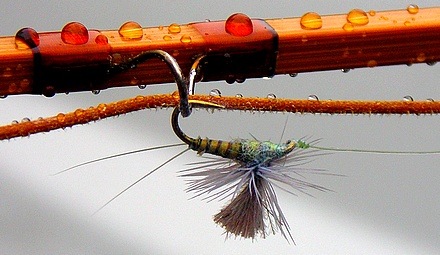 It rained hard all day. A waterproof point-and-shoot was perfect.
It rained hard all day. A waterproof point-and-shoot was perfect.I own a Canon DSLR -- an expensive, interchangeable-lens digital camera that offers a bewildering array of controls and settings. It's wonderful, yet it's also big, heavy, and -- this is important --
not waterproof.
Thus, it usually sits at home while a pair of waterproof, lightweight Pentax Optio point-and-shoot cameras do the Trout Underground's heavy photographic lifting.
After all,
when should I fall into the river, the waterproof point-and-shoot shrugs it off; if the Canon DSLR was along, I'd soon be scouring the Internet for a replacement (an
expensive replacement).
And yes, I regularly curse the point-and-shoots for the lack of manual controls, but a picture that's not quite what I wanted is better than the picture I never took.
Plus, a pocket-sized camera means shooting that stonefly on a branch doesn't involve minutes of twisting, unzipping, and maneuvering. The camera's right there.
Ponder the "Zen of the Picture Not Taken" for a minute, and you'll see the wisdom of a small, waterproof digital camera that's right at hand when you need it.
Sure, buy the DSLR if you want it, and you'll love it. I love mine.
But make sure your camera isn't hurting your photographic endeavors instead of helping them.
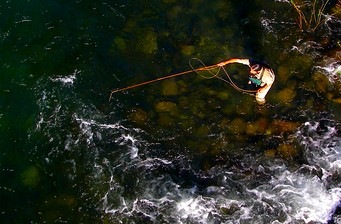 Another image "found" while fishing. Got camera?Zen Tip #2: Compose your pictures in two dimensions - as if you were painting them
Another image "found" while fishing. Got camera?Zen Tip #2: Compose your pictures in two dimensions - as if you were painting themThis is might be the single most important Zen photo tip you'll ever read (as if you'll ever see another Zen photo hints article).
Most amateur photographers make the same mistake; they pick up their camera and look
through the viewfinder (or LCD screen) instead of composing pictures
on it.
The principle at work is simple; you're building an image on a two-dimensional space the same way a painter arranges objects on a two-dimensional canvas.
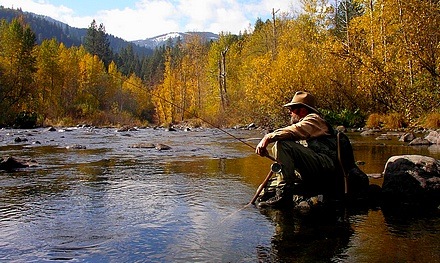 Centering Dave Roberts in the picture would have looked static. This is better.
Centering Dave Roberts in the picture would have looked static. This is better.If you pick up a camera and start looking
through the viewfinder (or LCD screen), your eye focuses only on the principal object of the photograph. The inevitable result is a dead-centered, too-far-away, boring image.
Next time you're shooting, take a second (and a deep breath), and look at the viewfinder like it was a frame around a painting. Compose your image within the confines of that frame, and yes, take a minute to move the frame around the subject.
What you're doing lies at the heart of the process;
you're not taking a snapshot, you're composing an image.
My best-ever photo instructor once stole our cameras, and sent us out into the world with small cardboard picture frames, suggesting we stop taking pictures and starting composing images.
It worked.
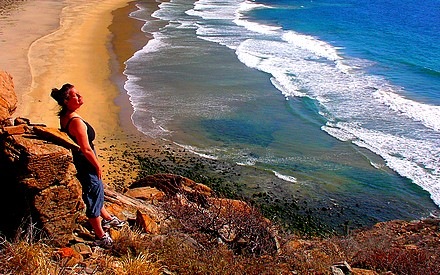 It's not a snapshot, it's a real-life painting of your trip. Any trip.
It's not a snapshot, it's a real-life painting of your trip. Any trip.So straighten the crooked horizon. Crop out the bright white (distracting) boulder. Try moving the subject of the photograph off-center (centered pictures often look static). See how including or eliminating objects will "pop" a photograph to life.
And yes, this is the time to
get closer to your subject. Quarter-inch high fishermen holding 1/32" inch long fish don't excite the average viewer. Fill the frame. Go big.
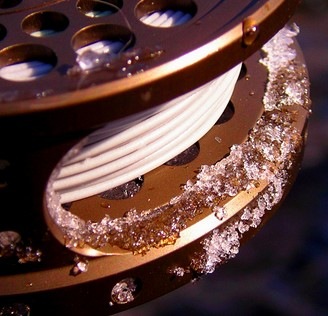 Sometimes, the details tell the story better than the landscapes.
Sometimes, the details tell the story better than the landscapes.All this only takes a couple seconds, and yes, the zen photographer
has a couple seconds.
Part II Coming Soon to an Underground Near YouThis one's getting big, so I'll split it, and run Part II soon.
I owe you three more Zen photo tips, and yes, because you
called and ordered today, I'm giving you an extra FREE
bonus Zen photo tip. (And isn't photographic peace of mind worth a lot more than free?)
[You can read Part II of my Zen Photo Tips Article here.] See you behind the camera, Tom Chandler.
Technorati Tags: photography,outdoor photography,zen photo tips